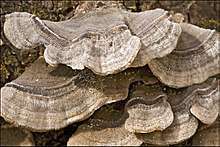Cerrena unicolor
| Cerrena unicolor | |
|---|---|
 | |
| Scientific classification | |
| Kingdom: | Fungi |
| Division: | Basidiomycota |
| Class: | Agaricomycetes |
| Order: | Polyporales |
| Family: | Cerrenaceae |
| Genus: | Cerrena |
| Species: | C. unicolor |
| Binomial name | |
| Cerrena unicolor | |
| Synonyms | |
Cerrena unicolor, commonly known as the mossy maze polypore,[1] is a species of poroid fungus in the genus Cerrena (Family: Polyporaceae). This saprobic fungus causes white rot.
Taxonomy
The fungus was originally described by French botanist Jean Bulliard in 1785 as Boletus unicolor,[2] when all pored fungi were typically assigned to genus Boletus. William Alphonso Murrill transferred it to Cerrena in 1903.[3] The fungus has acquired a long and extensive synonymy as it has been redescribed under many different names, and been transferred to many polypore genera.[4]
Description

Cerrena unicolor has fruit bodies that are semicircular, wavy brackets up to 10 centimeters (4 in) wide.[1] Attached to the growing surface without a stalk (sessile), the upper surface is finely hairy, white to grayish brown in color, and in zonate—marked with zones or concentric bands of color. The surface is often green from algal growth. The pore surface is whitish in young specimens, later turning gray in maturity. The arrangement of the pores resembles a maze of slots; the tubes may extend to 4 mm deep.[5] The spore print is white.
Spores are elliptical in shape, smooth, hyaline, inamyloid, and have dimensions of 5–7 by 2.5–4 µm.[5]
Ecology
Cerrena unicolor causes canker rot and decay in paper birch (Betula papyrifera) and sugar maple (Acer saccharum).[6] The fungus has a wide distribution, and is found in Asia, Europe, South America, and North America.[7]
Applications
Cerrena unicolor has been identified as a source of the enzyme laccase. This enzyme has potential applications in a wide variety of bioprocesses. C. unicolor is known to produce laccase in culture at more favorable conditions and in higher yield than other wood rotting fungi,[8][9] and research is focussing on ways to produce laccase cost-effectively on a large scale.[10]
References
- 1 2 Roody, William C. (2003). Mushrooms of West Virginia and the Central Appalachians. Lexington, Kentucky: University Press of Kentucky. p. 370. ISBN 0-8131-9039-8. Google Books
- ↑ Bulliard, J.B.F. (1789). Herbier de la France (in French). 9. pp. 385–432.
- ↑ Murrill, W.A. (1903). "A historical review of the genera of the Polyporaceae". Journal of Mycology. 9 (2): 87–102.
- ↑ "GSD Species Synonymy: Cerrena unicolor (Bull.) Murrill". Species Fungorum. Kew Mycology. Retrieved 2018-04-16.
- 1 2 "Cerrena unicolor (MushroomExpert.Com)". Retrieved 2009-01-30.
- ↑ Blanchette, Robert; Biggs, Alan (2013). Defense Mechanisms of Woody Plants Against Fungi. Springer Science & Business Media. p. 47. ISBN 978-3-662-01642-8.
- ↑ Zhishu, Bi; Guoyang, Zheng; Li, Taihui (1993). The Macrofungus Flora of China's Guangdong Province. Chinese University Press. p. 209. ISBN 978-962-201-556-2.
- ↑ Leonowicz A, Gianfreda L, Rogalski J, Jaszek M, Luterek J, Wojtaś-Wasilewska M, Malarczyk E, Dawidowicz A, Fink-Boots M, Ginalska G, Staszczak M, Cho N-S. (1997). "Appearance of laccase in wood-rotting fungi and its inducibility." Journal of Korean Wood Science and Technology 25: 29–36.
- ↑ Rogalski J, Dawidowicz A, Jóźwik E, Leonowicz A. (1999). Immobilization of laccase from Cerrena unicolor on controlled porosity glass. Journal of Molecular Catalysis (B: Enzymatic) 6: 29–39.
- ↑ Janusz, Grzegorz; Rogalski, Jerzy; Szczodrak, Janusz (2007). "Increased production of laccase by Cerrena unicolor in submerged liquid cultures". World Journal of Microbiology and Biotechnology. 23 (10): 1459–1464. doi:10.1007/s11274-007-9390-y.